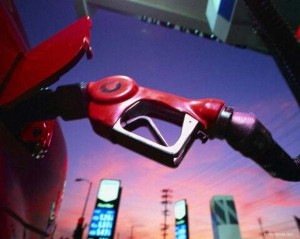Fuel prices are continuing the dizzying rollercoaster rate that has plagued motorists for most of 2012, the good news being a sudden dip in what most Americans are paying at the pump – even in California, where refinery issues recently nudged gas prices up and above record levels.
But the bad news is that an increasingly healthy economy could soon result in another surge at the pump.
According to the Energy Information Administration, the typical American motorist is currently paying $3.819 a gallon for self-serve regular unleaded. That’s down about 3.1 cents in a week – a savings that can add up to about $5 a month for the average commuter.
Prices have fallen across the country, says the EIA and other sources, with Oklahomans getting the best deal at $3.449, and South Carolinans close behind at $3.456. At the other end of the spectrum, California is still in record territory, at $4.573, according to tracking site GasBuddy.com, though that’s at least down a few cents from recent records.
A variety of refinery-based issues have plagued different regions of the country since earlier this year, including the Midwest and West Coast. California has arguably been hardest hit and in recent weeks its motorists have had the dubious distinction of not just paying more than drivers in Hawaii – where fuel prices normally run highest – but having set and reset price records several times in barely a month.
Even within individual states, fuel prices have been varying wildly, with Tulsa service stations averaging just $3.277, or about 17 cents below that state’s average. Santa Barbara, California, currently has the highest pump prices in the country, $4.719, or nearly 15 cents more than the Golden State’s average.
With many of the recent refinery problems resolved, motorists appear to be getting some relief. But how long that will last remains to be seen. Refineries have to meet regional requirements for seasonal blends – and such transitions often lead to short-term spikes.
But the bigger issue is one of overall demand. A weak U.S. economy, along with the European debt crisis and a manufacturing slowdown in China might worry economists but those are all factors reducing petroleum demand – and holding prices lower than they might have climbed this year. But in recent days, the American economy has begun showing solid signs of improvement and that isn’t being missed by petro-speculators.
Oil prices surged to $92 a barrel in early Tuesday trading in response to higher consumer spending and improved consumer confidence numbers. The U.S. Commerce Department noted that a two-month surge in retail orders, particularly in auto sales as well as smartphone devices like the Apple iPhone 5, was the strongest the country has seen in two years.
“The oil market is being driven by speculation,” cautioned a report by Frankfurt-based Commerzbank.
Whether traders will continue to push up crude remains to be seen and recent months have shown that even modest regional setbacks can cause prices to plunge again.
But if the American economy does sustain its current upward momentum, few analysts doubt that gas prices will once again start moving towards record levels.

